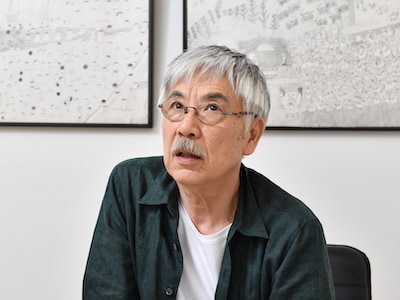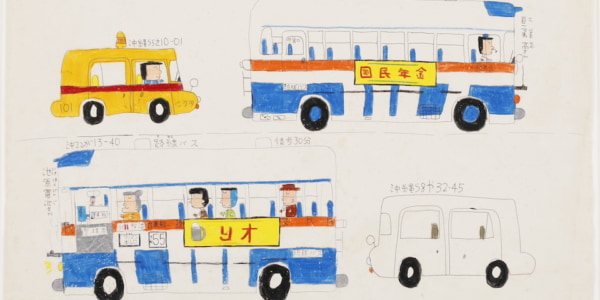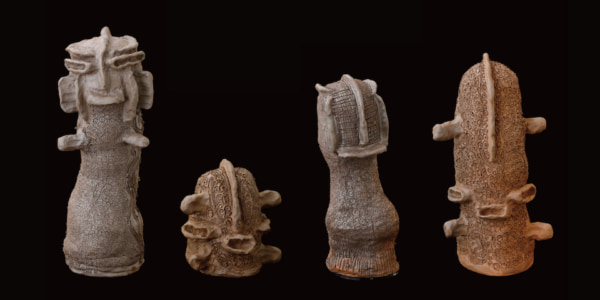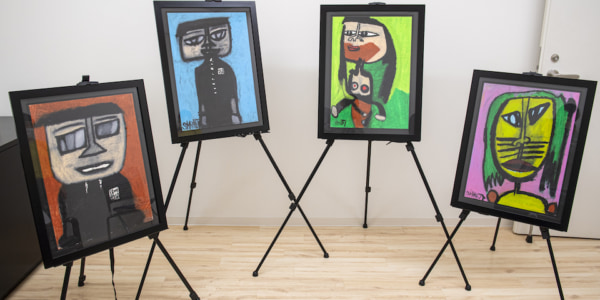Co-starring
HATANA Hirotaka(1976-)
Hatana was born in 1976. He lives in Shiga Prefecture. He carries out his creative works with dynamism, using India ink, crayons, pastels, and a range of other media. He began drawing in earnest at 〈Atelier Yamanami〉, which he joined after graduating from high school. Tokyo Tower is a frequent motif in his works. He began drawing the landmark some years after seeing it on a school trip. Today, he is a member of 〈Banban〉, and draws at this facility’s workshops. His works were exhibited in 2003 in Three/Free/Plea: An Exhibition of Three Banban Artists at the Gallery Maronie (Kyoto Prefecture), and the Art Brut Japonaise exhibition at the Halle Saint Pierre art museum in Paris in 2010.
![[Photograph (Works)]](https://www.diversity-in-the-arts.jp/admin/wp-content/uploads/2022/02/cff2484ffdb0465d48c14f853acb9ad7.jpg)
“Tokyo Tower” / 760×350mm / Pastel, crayon, and India ink on yellow cardboard / 2002 – 2003 / Collection of The Nippon Foundation
This tale unfolds in the Scottish countryside.
Tucked away in the mountains is a beautiful loch, and at the very top of a tower built on its banks there lived a king. He had always lived there alone, never venturing outside.
His retainers lived lower down in the tower, so they brought him his meals and took care of everything that needed to be done. Even though he lived alone, the king wanted for nothing. At the top of his high tower, from which he could look down over his kingdom whenever he wanted, the king lived happily.
The king’s days passed peacefully, until one day a bustling and commotion at the base of the tower finally prompted him to make an attempt to descend the tower. However, the doors were heavy and he struggled to open them. There was one set of doors after another, so that it seemed impossible that he would ever reach the lower levels. When he finally opened the last door and arrived at ground-level, he found his very last retainer on the point of leaving.
“What’s happening? Where are you going?”
“Your Majesty, it’s not safe here, so we’re running away. You should escape, too, Your Majesty.” “What makes you say that it’s not safe?” “Does Your Majesty not know? There’s a dragon that wanders the skies in the dead of night!” “What, a dragon?”
While the king was overcome with shock, all of his retainers picked up and left.
The king didn’t run away but remained behind, alone. He decided to make his way back to the top of the tower, and gazed out from its round window. As he looked out, evening began to draw in, and a scattering of what looked like footprints began to appear here and there. Unbelievably, they were even reaching into the sky. The true form of whatever was leaving the footprints was invisible, but the king realized that it could be none other than the dragon.
![[Photograph (Works)]](https://www.diversity-in-the-arts.jp/admin/wp-content/uploads/2022/02/1af238a6fc045fc72efb678b5a0a15a0.jpg)
“Tokyo Tower” / 760×350mm / Pastel, crayon, and India ink on yellow cardboard / 2002 – 2003 / Collection of The Nippon Foundation
Meanwhile, the retainers and villagers had escaped together.
Remembering the king, a villager remarked,
“I’m sure the king must be making a run for it , too.”
“No, His Majesty is probably still in that tower by himself,”
replied the retainer who had been the last to see the king.
The villagers who heard this buzzed with disbelief.
“No way!”
“What on earth does he think he’s doing in that scary place?”
![[Photograph (Works)]](https://www.diversity-in-the-arts.jp/admin/wp-content/uploads/2022/02/ec4add61f0538514d53b942ccab426f1.jpg)
“Tokyo Tower” / 760×340mm / Pastel, crayon, and India ink on yellow cardboard / 2002 – 2003 / Collection of The Nippon Foundation
Even as night fell, the footprints of the dragon continued to dot across the entire sky one after another, as before.
“I wonder what the dragon does during the day?”
one of the villagers asked one day.
In response, a villager who claimed to have caught a glimpse of the dragon in the daytime came forward.
Apparently, the silhouette of a dragon-like creature could be seen in a loch, poking its head up above the surface.
And this loch was the one next to where the tower stood.
Its name was Loch Ness.
When night fell, the Loch Ness monster turned into a dragon and flew around the tower, leaving footprints dotted around the sky. The king, who had realized this, sought to destroy the monster and fired arrows at it from the top of the tower, but none of them found their mark.
His arrows should have been hitting their target, but even as he fired and fired, the dragon flew around unhurt. The king didn’t give up, but continued to shoot arrows at the dragon day after day.
The villagers had been watching the king doing this from afar, but at some point they found that they could no longer catch sight of him.
“It looks like the king has vanished.”
“So has he fallen from the tower and died, do you think?”
“No, I’m sure he must have run away in fear of the dragon.”
As night fell and they gazed at the footprints floating in the sky, gossiping together about the king’s fate, one of the villagers noticed something.
“Hey, wait a minute, the footprints are a slightly different shape than they were before!”
At these words, a retainer who had frequented the king’s tower gave a start.
“Those footprints look just like the ones left by the shoes His Majesty used to wear.”
“Are you telling us those footprints are the king’s?”
“The king is wandering the skies in the middle of the night?”
“Maybe the king turned into a dragon?”
“Hold on, isn’t it conceivable that he was a dragon all along?”
Each and every villager joined in the clamorous exchange of ideas, but after a while they stopped theorizing.
This was because it had been decided by the newly established parliament that the king must no longer be spoken of.
Ever since this decree had been sent out, anyone who had rebelled against it had had their head chopped off and kicked all the way out of the village. It was a time of impending changes for modern democracy and scientific advances were inspiring a wholesale rejection of any superstitious elements.
Even so, the fact remained that there were footprints in the sky. And so it was declared that they were “nothing more than a naturally occurring atmospheric illusion.” Any further investigation into the matter was forbidden.
Yet a single, tacit concession was made in allowing the phenomenon to be named “the King’s Footprints.” So if you’re interested in optical illusions, you can still go and see them anytime. I’m sure the king is looking forward to your visit.
![[Photograph]](https://www.diversity-in-the-arts.jp/admin/wp-content/uploads/2022/02/A2A9393-2.jpg)
![[Photograph] メガネを手に、なにか思い浮かんだ様子のイッセーさん](https://www.diversity-in-the-arts.jp/admin/wp-content/uploads/2022/02/A2A9552.jpg)
Issey Ogata’s Wildly Imaginative Art Appreciation Techniques
As actor, playwright, and director of his one-man show, Issey Ogata brings new worlds to life every day. We asked him for tips on having fun with the power of unfettered imagination.
![[Photograph] スコッチドラゴンの草稿が書かれた原稿用紙と万年筆](https://www.diversity-in-the-arts.jp/admin/wp-content/uploads/2022/02/A2A9314.jpg)
The stage is set, a timeline is added, and the story unfolds.
A world is built by the voicing of words
Place is important in stories. I have to establish place first, before I can wonder about who’s there with me. In the context of a play, place would the theatrical scenery made for me to appear in.
For this idea, I started out with the Tower of London. I thought it would make for an interesting setting if there was a king in the tower, and the tower was both his castle and his prison. But setting things up in this way didn’t explain the footprints. So I left the city behind and took off for Loch Ness. I think the boundless quality of these pictures acted as a force pulling me out there.
If place acts as a story’s theatrical scenery, its structure comes to me from the works of art themselves. I am generally viewing not one but several pieces. And this allows the unfolding of the story to emerge.
If there are around three pieces, a timeline will emerge between them and the story can develop. The timeframe intrinsic to the works themselves comes to the fore. The presence of that timeframe drives me to develop the story. Because a tale and the time in which it is spun are the same thing.
The power that drives a story forward is not to be found in how you go about creating your main characters but in the words that each of those main characters have to say. Because it is words that establish a character.
You can reveal a character through his or her superficial habits of speech, but it is also with words that we show how a character fundamentally sees the world. People understand the world through words, so these words themselves become the character.
The words of someone whose worldview holds that human relationships are “dog-eat-dog” and those of someone with an “everyone is equal” worldview will be different. These things come in pairs, and are not fully complete one without the other. The surrounding world of each is brought forth in words.
In the one-man plays that I’m always doing, I have my audience imagining what the other person in the conversation must have said just from the reactions of the character on stage. The audience won’t be able to imagine what the other person said if I just act a little surprised, so my responses are always outsize. That’s why I tend to stand out whenever I’m acting in a TV series. Because I’m used to plays where the audience is relying on my reactions to fire their imaginations, haha!
![[Photograph] 今回の共演者、畑名さんの絵画を見つめるイッセーさん](https://www.diversity-in-the-arts.jp/admin/wp-content/uploads/2022/02/A2A0418-1.jpg)
![[Photograph] 今回の共演者、畑名さんの絵画を見つめるイッセーさん](https://www.diversity-in-the-arts.jp/admin/wp-content/uploads/2022/02/A2A0395.jpg)
![[Photograph] 手を出し](https://www.diversity-in-the-arts.jp/admin/wp-content/uploads/2022/02/A2A0370.jpg)
![[Photograph] にっこりと笑うイッセーさん](https://www.diversity-in-the-arts.jp/admin/wp-content/uploads/2022/02/A2A0405.jpg)
[Corporation] Yanaka no Okatte, NPO Taito Cultural & Historical Society, Ueno-Sakuragi Denchu Hirakushi House and Atelier




![[Photograph] メガネを手に、なにか思い浮かんだ様子のイッセーさん](https://www.diversity-in-the-arts.jp/admin/wp-content/uploads/2022/02/7cf4974f6ace7536cc9f6f6a0e2222ad.jpg)



